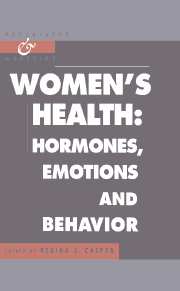Book contents
- Frontmatter
- Contents
- Preface
- 1 Growing up female
- 2 Reproduction and its psychopathology
- 3 Women's sexual function and dysfunction
- 4 Gender differences in brain morphology and in psychiatric disorders
- 5 Thyroid hormones in major depressive disorder and bipolar disorder
- 6 The hypothalamic-pituitary-adrenocortical system
- 7 The cost of starvation: Eating disorders
- 8 Coronary artery disease and women: Estrogens and psychosocial and lifestyle risk factors
- 9 The psychophysiology of breast cancer: Disease, hormones, immunity, and stress
- 10 The psychopharmacology of women
- 11 Intervention trials concerned with disease prevention in women
- References
- Index
1 - Growing up female
Published online by Cambridge University Press: 08 February 2010
- Frontmatter
- Contents
- Preface
- 1 Growing up female
- 2 Reproduction and its psychopathology
- 3 Women's sexual function and dysfunction
- 4 Gender differences in brain morphology and in psychiatric disorders
- 5 Thyroid hormones in major depressive disorder and bipolar disorder
- 6 The hypothalamic-pituitary-adrenocortical system
- 7 The cost of starvation: Eating disorders
- 8 Coronary artery disease and women: Estrogens and psychosocial and lifestyle risk factors
- 9 The psychophysiology of breast cancer: Disease, hormones, immunity, and stress
- 10 The psychopharmacology of women
- 11 Intervention trials concerned with disease prevention in women
- References
- Index
Summary
Population statistics consistently record more male than female human births (Babb, 1995), the outcome of a significantly higher conception rate for males (McMillen, 1979). Such sex ratio bias occurs in several species, where research is now examining environmental and physiologic conditions as well as maternal effects that influence the sex ratio at conception and at birth (Bacon and McClintock, 1994). This higher birth rate notwithstanding, beginning at birth and throughout life, male mortality tends to be significantly higher. In the first year of life, 25 percent more male than female infants die, and in adult life the male:female mortality ratio exceeds 2:1 (U.S. Bureau of the Census, 1990).
This phenomenon of women outranking men in survival is relatively new. Until the last century, before the discovery of antisepsis and antibiotics, many young women died in their child beds as a result of birth complications, hemorrhages, and postpartum infections. In 1868, maternal mortality rates were 84.4:1,000 births as opposed to 5:1,000 births in 1986 (O'Dowd and Philipp, 1994). Furthermore, some illnesses are unique to women. Medical complications and pathology associated with the female reproductive system, with pregnancy, and with child rearing confer increased risks of physical and psychological morbidity.
This first chapter presents a necessarily abbreviated account of normal female somatic and psychological development as an introduction to the material in the following chapters, which cover disorders that are known to affect women uniquely or disproportionately.
Keywords
- Type
- Chapter
- Information
- Women's HealthHormones, Emotions and Behavior, pp. 1 - 13Publisher: Cambridge University PressPrint publication year: 1997
- 1
- Cited by

